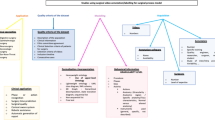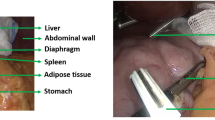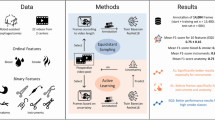Abstract
Background
The growing interest in analysis of surgical video through machine learning has led to increased research efforts; however, common methods of annotating video data are lacking. There is a need to establish recommendations on the annotation of surgical video data to enable assessment of algorithms and multi-institutional collaboration.
Methods
Four working groups were formed from a pool of participants that included clinicians, engineers, and data scientists. The working groups were focused on four themes: (1) temporal models, (2) actions and tasks, (3) tissue characteristics and general anatomy, and (4) software and data structure. A modified Delphi process was utilized to create a consensus survey based on suggested recommendations from each of the working groups.
Results
After three Delphi rounds, consensus was reached on recommendations for annotation within each of these domains. A hierarchy for annotation of temporal events in surgery was established.
Conclusions
While additional work remains to achieve accepted standards for video annotation in surgery, the consensus recommendations on a general framework for annotation presented here lay the foundation for standardization. This type of framework is critical to enabling diverse datasets, performance benchmarks, and collaboration.


Similar content being viewed by others
References
McKinley SK, Hashimoto DA, Mansur A, Cassidy D, Petrusa E, Mullen JT, Phitayakorn R, Gee DW (2019) Feasibility and perceived usefulness of using head-mounted cameras for resident video portfolios. J Surg Res 239:233–241
Greenberg CC, Byrnes ME, Engler TA, Quamme SP, Thumma JR, Dimick JB (2021) Association of a Statewide Surgical Coaching Program with Clinical Outcomes and Surgeon Perceptions. Ann Surg. https://doi.org/10.1097/SLA.0000000000004800
Manabe T, Takasaki M, Ide T, Kitahara K, Sato S, Yunotani S, Hirohashi Y, Iyama A, Taniguchi M, Ogata T, Shimizu S, Noshiro H (2020) Regional education on endoscopic surgery using a teleconference system with high-quality video via the internet: Saga surgical videoconferences. BMC Med Educ 20:329
Hashimoto DA, Rosman G, Rus D, Meireles OR (2018) Artificial intelligence in surgery: promises and perils. Ann Surg 268:70–76
Gibaud B, Forestier G, Feldmann C, Ferrigno G, Gonçalves P, Haidegger T, Julliard C, Katić D, Kenngott H, Maier-Hein L, März K, de Momi E, Nagy DÁ, Nakawala H, Neumann J, Neumuth T, Rojas Balderrama J, Speidel S, Wagner M, Jannin P (2018) Toward a standard ontology of surgical process models. Int J Comput Assist Radiol Surg 13:1397–1408
Garrow CR, Kowalewski K-F, Li L, Wagner M, Schmidt MW, Engelhardt S, Hashimoto DA, Kenngott HG, Bodenstedt S, Speidel S, Müller-Stich BP, Nickel F (2020) Machine learning for surgical phase recognition: a systematic review. Ann Surg. https://doi.org/10.1097/SLA.0000000000004425
Ward TM, Fer DM, Ban Y, Rosman G, Meireles OR, Hashimoto DA (2021) Challenges in surgical video annotation. Comput Assist Surg 26(1):58–68
Deng J, Dong W, Socher R, Li L, Kai Li, Li Fei-Fei (2009) ImageNet: A large-scale hierarchical image database. In: 2009 IEEE Conference on Computer Vision and Pattern Recognition. pp 248–255
Bowman SR, Angeli G, Potts C, Manning CD (2015) A large annotated corpus for learning natural language inference. arXiv [cs.CL]
Gokaslan A, Cohen V (2019) Openwebtext corpus. http://Skylion007.github.io/OpenWebTextCorpus
Zhu Y, Kiros R, Zemel R, Salakhutdinov R, Urtasun R, Torralba A, Fidler S (2015) Aligning books and movies: Towards story-like visual explanations by watching movies and reading books. In: Proceedings of the IEEE international conference on computer vision. pp 19–27
Geiger A, Lenz P, Stiller C, Urtasun R (2013) Vision meets robotics: the KITTI dataset. Int J Rob Res 32:1231–1237
Varadarajan B, Reiley C, Lin H, Khudanpur S, Hager G (2009) Data-derived models for segmentation with application to surgical assessment and training. Med Image Comput Comput Assist Interv 12:426–434
Katić D, Wekerle A-L, Gärtner F, Kenngott H, Müller-Stich BP, Dillmann R, Speidel S (2014) Knowledge-driven formalization of laparoscopic surgeries for rule-based intraoperative context-aware assistance. Information processing in computer-assisted interventions. Springer, New York, pp 158–167
Ahmadi S-A, Sielhorst T, Stauder R, Horn M, Feussner H, Navab N (2006) Recovery of surgical workflow without explicit models. Med Image Comput Comput Assist Interv 9:420–428
Anteby R, Horesh N, Soffer S, Zager Y, Barash Y, Amiel I, Rosin D, Gutman M, Klang E (2021) Deep learning visual analysis in laparoscopic surgery: a systematic review and diagnostic test accuracy meta-analysis. Surg Endosc. https://doi.org/10.1007/s00464-020-08168-1
Bhattacharyya SB (2015) Introduction to SNOMED CT. Springer
van Amsterdam B, Clarkson M, Stoyanov D (2021) Gesture recognition in robotic surgery: a review. IEEE Trans Biomed Eng. https://doi.org/10.1109/TBME.2021.3054828
Reiley CE, Hager GD (2009) Task versus subtask surgical skill evaluation of robotic minimally invasive surgery. Med Image Comput Comput Assist Interv 12:435–442
Sculley D, Holt G, Golovin D, Davydov E, Phillips T, Ebner D, Chaudhary V, Young M, Crespo J-F, Dennison D (2015) Hidden technical debt in machine learning systems. Adv Neural Inf Process Syst 28:2503–2511
Cockburn A (2001) Writing effective use cases. Pearson Education India
Surgical AI and Innovation Laboratory. SAIIL_public. https://github.com/SAIIL/SAIIL_public/
Twinanda AP, Shehata S, Mutter D, Marescaux J, de Mathelin M, Padoy N (2017) EndoNet: a deep architecture for recognition tasks on laparoscopic videos. IEEE Trans Med Imaging 36:86–97
Hashimoto DA, Rosman G, Witkowski ER, Stafford C, Navarette-Welton AJ, Rattner DW, Lillemoe KD, Rus DL, Meireles OR (2019) Computer vision analysis of intraoperative video: automated recognition of operative steps in laparoscopic sleeve gastrectomy. Ann Surg 270:414–421
Ward TM, Hashimoto DA, Ban Y, Rattner DW, Inoue H, Lillemoe KD, Rus DL, Rosman G, Meireles OR (2020) Automated operative phase identification in peroral endoscopic myotomy. Surg Endosc. https://doi.org/10.1007/s00464-020-07833-9
Acknowledgements
The authors thank SAGES staff Sallie Matthews, Jillian Kelly, Jason Levine, and Shelley Ginsberg for their administrative support in this work. We also thank Dr. Aurora Pryor for her support as SAGES leadership. The SAGES Video Annotation for AI Working Groups: Includes all members from Table 1.
Funding
This work was supported by the SAGES Foundation, Digital Surgery, Imagestream, Intuitive Surgical, Johnson & Johnson CSATS, Karl Storz, Medtronic, Olympus, Stryker, Theator, and Verb Surgical.
Author information
Authors and Affiliations
Consortia
Corresponding authors
Ethics declarations
Disclosures
Ozanan Meireles is a consultant for Olympus and Medtronic and has received research support from Olympus. Guy Rosman is an employee of Toyota Research Institute (TRI); the views expressed in this paper do not reflect those of TRI or any other Toyota entity. He has received research support from Olympus. Amin Madani is a consultant for Activ Surgical. Gregory Hager is a consultant for theator.io and has an equity interest in the company. Nicolas Padoy is a consultant for Caresyntax and has received research support from Intuitive Surgical. Thomas Ward has received research support from Olympus. Daniel Hashimoto is a consultant for Johnson & Johnson and Verily Life Sciences. He has received research support from Olympus and the Intuitive Foundation. Maria S. Altieri, Lawrence Carin, Carla M. Pugh and Patricia Sylla have no conflicts of interest or financial ties to disclose.
Additional information
Publisher's Note
Springer Nature remains neutral with regard to jurisdictional claims in published maps and institutional affiliations.
The SAGES Video Annotation for AI Working Groups are listed in Table 1.
Supplementary Information
Below is the link to the electronic supplementary material.
Rights and permissions
About this article
Cite this article
Meireles, O.R., Rosman, G., Altieri, M.S. et al. SAGES consensus recommendations on an annotation framework for surgical video. Surg Endosc 35, 4918–4929 (2021). https://doi.org/10.1007/s00464-021-08578-9
Received:
Accepted:
Published:
Issue Date:
DOI: https://doi.org/10.1007/s00464-021-08578-9




